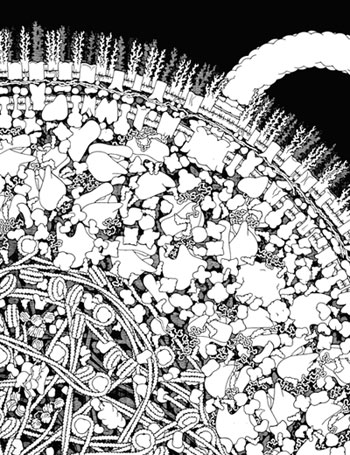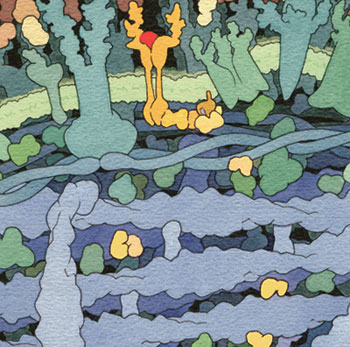The Living Cell
By Felice Frankel
David Goodsell of the Scripps Research Institute discusses illustrating the complexity of cells
David Goodsell of the Scripps Research Institute discusses illustrating the complexity of cells

DOI: 10.1511/2005.54.354
I vividly recall first seeing David Goodsell's work about 12 years ago during my first visit to the Scripps Research Institute, where he is a research scientist. There it was, screaming at me through the art and illustrations surrounding me in his office—an "aha!" moment, a revelation that, in fact, we'd been doing it all wrong! Could our depictions of the cell have been (albeit unintentionally) deceptive and dishonest? Textbooks, magazines and journal articles had been failing to tell the whole truth in their depictions of cellular structure; more important, they were sending out wrong visual messages in the form of edited-down diagrams that failed to communicate the cell's complexity. Perhaps if we were shown David's drawings as children, we would now have an easier time thinking about complex systems.

F. F. I wonder if you remember the first time you looked at a typical textbook drawing of cellular structure and became aware that the illustration was not giving the "real" story specifically about how packed cells really are?
D. G. There is one illustration from a book that comes to mind. It is from John Pfeiffer's book The Cell, published as part of the Time-Life science series back in 1964. I read this book over and over, and there is one beautiful cutaway picture of a cell, beautifully airbrushed in bright colors. Ever since then, this has been the picture I carry in my mind of what a cell looks like. It wasn't until graduate school, when I was working on molecular structures myself, that I saw the disconnect between this beautiful, smooth image and the reality of the cell.
F. F. Do you remember thinking at the time that you might, at some point, get involved with the visual representation of molecular biology, or did that come later?
D. G. My grandfather started me painting when I was in elementary school, but I only started calculating pictures of molecules in graduate school at UCLA. The crystallography labs had a new Evans & Sutherland Multi-Picture System, which created pictures composed of vivid colored lines and dots, so I got to work and wrote some programs to display DNA structures. Ever since then, molecular illustration has been a big part of all of my work.
F. F. Some of your representations seem to emulate a particular style first introduced by Art Olson and Mike Pique at Scripps. I am referring to a look that uses smooth molecular surfaces rendered with a shiny surface, like a plastic model. Yours have a more "hand-drawn" illustrative style and perhaps are more accessible to the public than the computer graphic versions. Would you say that your collaboration with those who work with computer graphics in molecular biology is a strong one?

D. G. Yes, I did postdoctoral research with Art Olson in the Molecular Graphics Laboratory, and we still work closely on a wide range of molecular graphics projects. He and Mike have used advanced rendering techniques for years to create these hyper-realistic images of molecular models. I gradually moved to my own current style, which uses outlines and flat colors, when I started doing these cellular pictures. I wanted a style that blurred the line between my molecular images, created with computer graphics directly from experimental atomic structures, and my cellular illustrations, which I paint or draw by hand. In this work, I like to allow viewers the ability to view a molecular structure and then find it in a cell, easily moving back and forth between the two scale levels.
F. F. Do you consider your work art or science?
D. G. When I approach a new picture, I am not thinking of it as Art. My goal is to create an illustration of what we might see if we could enlarge the cell, and that goal is best described as scientific illustration rather than fine art. I am getting more chances these days, however, to approach this subject with an artistic goal, and I'm looking forward to seeing where that takes the work.
Click "American Scientist" to access home page
American Scientist Comments and Discussion
To discuss our articles or comment on them, please share them and tag American Scientist on social media platforms. Here are links to our profiles on Twitter, Facebook, and LinkedIn.
If we re-share your post, we will moderate comments/discussion following our comments policy.